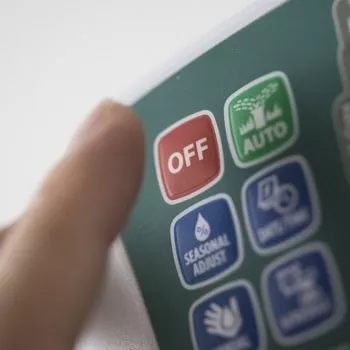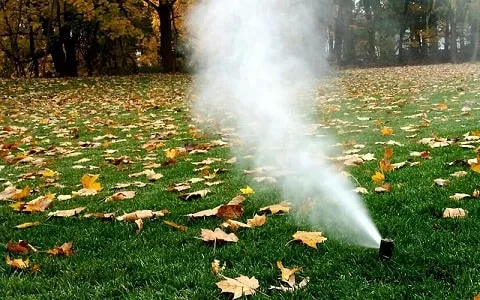Depending on your climate, you may or may not need to winterize your sprinkler system. For the large majority of people living outside the Sun Belt, winterization is highly recommended. So if it's a need in your area, you should learn how to winterize a sprinkler system. You're better safe than sorry when it comes to your home.

What Is Sprinkler Winterization?
In short, it's the preparation of your sprinkler system for winter. You can either drain your system or blow it out. Proper winterization ensures your system is protected from the elements and is maintained for long-lasting results.
As we all know, water expands when it freezes. This creates issues in the winter if there is sufficient water remaining in your PVC pipes. Remember, even if you live in an area where air temperatures rarely reach freezing, your pipes are 6-12 inches below the ground and can be subjected to lower temperatures than you realize. Come springtime, you do not want to turn on your system and find out you have cracked or broken pipes or split valves. It will take time and money to diagnose and repair. With the proper precautions, you can avoid the headache of spring repairs with fall measures.
When to Winterize Sprinklers?
It is strongly recommended that you prepare for winter by blowing out a sprinkler system before the first widespread freeze. Why? Even during the first freeze, underground sprinkler systems can be harmed. By winterizing your sprinkler system in a timely manner, you can save money and headaches down the road. Check out this handy guide that will help give you an idea when to expect the first freeze in your part of the country.
How to Winterize Sprinklers
There are a few different ways to go about this. One method, as mentioned is to blow out the sprinkler system. There is a much easier method that doesn't always get the job done, simply drain the system. We'll start with the sprinkler blow out:
Blowing Out Your Sprinkler System

Properly built sprinkler systems have check valves located at all the low spots in the system, which are intended to drain as soon as pressure is released. Because the lines are underground, it is hard to know if they are even there and if they are still working. Blowing out your sprinkler system is a great way to ensure that your water lines stay intact during the cold winter.
Below you will find instructions for the most commonly used way to blow out any residual water in a sprinkler system. You will l need eye protection, a compressor, and a valve key. If desired, an insulated blanket to kneel on may be helpful, as would a flashlight (for peering down the access pipe that leads to your stop and waste valve).
Method 1 (Recommended):
- Turn off the supply of water to your sprinkler system. This can be done by inserting your valve key into the access pipe. Once the key is securely set onto the valve handle, turn the key one direction until it stops. Turning the valve handle part-way may lead to constant water flow through the drain hole (located on all stop and waste valves). You can expect some water to leak through this hole anyway, but any valve that flows for more than a couple minutes, once turned, needs to be revisited. This is also the time to open the vents for a minute or two on your reduced pressure backflow valve (if you have one). A simple flat head screwdriver is all you will need for that.
- Open the sprinkler valve that controls the sprinklers the farthest away from the valves. There may be water in the system so give it a few minutes to drain before blowing out.
- Turn on the compressor and attach your air hose. It is a good idea to make sure that your compressor does not exceed around 80psi while blowing out sprinklers. This will ensure your safety and the security of the system components.
- Locate the air compressor port. If you have one, it will typically be near the valves. We recommend this set up because it is the easiest and cleanest way to get water out of your sprinkler lines.
- Plug your air hose into the airport and open the valve. Lots of noise and possibly lots of water will be forced above ground and through your sprinklers, so you may get wet. You can turn off the valve or unplug the air hose if your compressor needs to catch up with the release of air. You should be able to tell when the lines are free of water when the sputtering sounds stop and the air is all that comes from the pop-up sprinkler heads.
Method 2:
- See step 1 above.
- See step 2 above.
- See step 3 above.
- Locate the sprinkler that is at the highest spot in the zone you are blowing out, and remove the nozzle. The idea here is that you will be forcing air through this sprinkler to the rest of the sprinklers on that zone/station. You will need an air nozzle with a trigger and a rag.
- Plug your air hose nozzle into the sprinkler and wrap the rag around it. Squeeze the rag tight and pull the trigger. The idea is that the tight rag helps to create the seal so the air is forced down the line. It might take a couple of tries to get it just right. Again, lots of noise and possibly lots of water will be forced above ground.
- Close the sprinkler valve and repeat steps 1-5 on other zones. Now that you know to blow out one station, you can move on to the others that also need your attention.
Tips: Please take note about protecting your pets. Domestic animals, both cats, and dogs are sensitive to sounds outside the range of human hearing and compressors can be very loud. Remember to protect your pet's sensitive ears by keeping them inside for this project.
How to Drain a Sprinkler System
There are two main methods for draining your sprinkler system:
Manual Systems
- Drain water from the mainline. Your sprinkler system should have a drain valve at the end of the line.
- Drain remaining water stuck in between the shut-off valve and the backflow by opening the drain cap on the stop/waste valve.
- Open the test cocks that are found on the backflow. If you have check valves on your sprinklers, you need to pull them up to properly drain the system.
- Give it time to let all the water drain out, then close the manual drain valve(s).
Automatic Systems
Automatic systems make the job easy and you can get all the components you need for a Toro sprinkler or Rain Bird sprinkler installation here at PlumbersStock. You use this method when you have automatic drain valves* at the low points in your setup.
- Shut off the water supply.
- Activate one of the sprinkler stations, which will release pressure from the system, allowing the automatic drains to trigger.
- See step 2 above.
- See step 3 above.

*What Is an Automatic Drain Valve?
Automatic Drain valves, also known as king drains, release the water in a sprinkler line as soon as the pressure is relieved. The pressure holds the water in place, just like covering the top of a straw in a glass of water will not allow the water to release from the straw until you move your finger. This is why opening each sprinkler valve, in turn, is so important. Skipping this step will eventually lead to broken pipes.
Should I Blow Out My Sprinklers?
Just because you can do it, doesn't mean you should. It might be a good idea to leave a blow out to the professionals. If you use too much pressure, you can cause permanent damage to the pipes, defeating the whole purpose of winterization. If you are not experienced with the task, it might be too risky to perform without someone experienced on hand. If you are determined to do it yourself, just make sure you do not use more than 80 PSI on PVC piping. It is not recommended to go beyond that threshold. There you have it. With all the information you need on how to winterize a sprinkler system, you are ready to take on the task and then enjoy the few months you have with little-to-no yard work until spring comes. Remember, you can save on everything from sprinkler timers to rain sensors at PlumbersStock.
Related Resources:
Spring Maintenance Checklist for Sprinklers
Late Summer Lawncare Tips
When Should You Water Your Lawn



